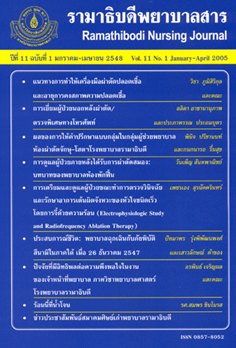การพัฒนาแนวปฏิบัติการพยาบาลเพื่อป้องกันการบาดเจ็บของผิวหนังบริเวณจมูกในทารกเกิดก่อนกำหนดที่ได้รับการช่วยหายใจด้วยแรงดันบวกอย่างต่อเนื่องทางจมูก
Main Article Content
Abstract
บทคัดย่อ
วัตถุประสงค์ของการศึกษาครั้งนี้ เพื่อพัฒนาแนวปฏิบัติการพยาบาลเพื่อป้องกันการบาดเจ็บของผิวหนังบริเวณจมูกในทารกเกิดก่อนกำหนดที่ได้รับการช่วยหายใจด้วยแรงดันบวกอย่างต่อเนื่องทางจมูก ด้วยการทบทวนหลักฐานเชิงประจักษ์อย่างเป็นระบบโดยใช้ความรู้เกี่ยวกับ ทารกเกิดก่อนกำหนด พยาธิสรีรวิทยาในเรื่องผิวหนัง และปัจจัยที่ทำให้เกิดแผลบริเวณผิวหนัง รอบจมูกในทารกเกิดก่อนกำหนด ได้แก่ อุปกรณ์เครื่องช่วยหายใจด้วยแรงดันบวกอย่างต่อเนื่อง อุปกรณ์และวิธีการดูดเสมหะ การตั้งอุณหภูมิเครื่องให้ความชื้น ปัจจัยจากตัวทารก ประกอบด้วย ภาวะเกิดก่อนกำหนด โครงสร้างของจมูกและผิวหนัง ความไม่สุขสบายต่างๆ มาเป็นกรอบแนวคิด ซึ่งมีงานวิจัยที่เกี่ยวข้องทั้งหมด 19 เรื่อง แนวปฏิบัติการพยาบาลที่พัฒนาขึ้นนี้ ได้รับการตรวจ สอบความถูกต้องของเนื้อหา ความตรงกับปัญหาทางคลินิกที่ต้องการแก้ไข ความน่าเชื่อถือและ ความเป็นไปได้ที่จะนำไปใช้ในการปฏิบัติจากผู้ทรงคุณวุฒิ 5 ท่านที่มีความเชี่ยวชาญในการดูแล ทารกเกิดก่อนกำหนด แนวปฏิบัติการพยาบาลที่สร้างขึ้นนี้ประกอบด้วย 1) การเลือกขนาดท่อ ช่วยหายใจทางจมูก (nasal prongs) 2) การใส่ท่อช่วยหายใจทางจมูกและการยึดตรึง 3) การดูแล ขณะทารกได้รับการใส่ท่อช่วยหายใจทางจมูก 4) การเฝ้าระวังและประเมินภาวะแทรกซ้อนจาก การใส่ท่อช่วยหายใจทางจมูก 5) การดูดสารคัดหลั่งในรูจมูก 6) การปรับตั้งเครื่องให้ความชื้น และอุณหภูมิเหมาะสมและ7) การดูแลเพื่อส่งเสริมความสุขสบาย การศึกษาครั้งนี้มีข้อเสนอแนะว่าควรนำแนวปฏิบัติการพยาบาลนี้ไปทดลองใช้ในหน่วยงาน พร้อมทั้งมีการประเมินและติดตามผล
คำสำคัญ: แนวปฏิบัติการพยาบาล การช่วยหายใจด้วยแรงดันบวกอย่างต่อเนื่องทางจมูก ทารกเกิดก่อนกำหนด การบาดเจ็บของผิวหนังบริเวณจมูก
Abstract
The purpose of this study was to develop clinical nursing practice guideline to prevent nasal skin injury from nasal continuous positive airway pressure (CPAP) in premature infants. A literature review of evidence-based research was used to elicit knowledge about premature infants, skin pathophysiology, and factors of nasal skin injuries in premature infants and then was synthesized for the conceptual framework, including CPAP equipment, suction equipments and methods, humidifier temperature setting, infant factors consisted of preterm labor, nasal & skin structure, and uncomfortableness. There were 19 published research studies related to the prevention of nasal skin injury from nasal continuous positive airway pressure in premature infants. Five experts in the fields of neonatology and neonatal nursing validated the guideline for accuracy in contents, clinical relevance, scientific merits, and potential for use in clinical practice. The guideline consists of the following steps: 1) selection of the proper size of nasal prongs, 2) applying prongs to infant’s nares with strap, 3) nursing care during using nasal prongs, 4) monitoring and evaluation complications from nasal prongs, 5) nasopharyngeal suction, 6) the most appropriate setting of the humidifier’s temperature, and 7) nursing care for comfort promotion. It is recommended that this guideline should be tested within the neonatal unit and outcomes should be evaluated.
Keywords: Clinical nursing practice guideline, Nasal continuous positive airway pressure, Premature infants, Nasal skin injury
Article Details
บทความ ข้อมูล เนื้อหา รูปภาพ ฯลฯ ที่ได้รับการตีพิมพ์ในรามาธิบดีพยาบาลสาร ถือเป็นลิขสิทธิ์ของวารสาร หากบุคคลหรือหน่วยงานใดต้องการนำทั้งหมดหรือส่วนหนึ่งส่วนใดไปเผยแพร่หรือเพื่อกระทำการใด ใด จะต้องได้รับอนุญาตเป็นลายลักษณ์อักษรจากรามาธิบดีพยาบาลสารก่อนเท่านั้น


